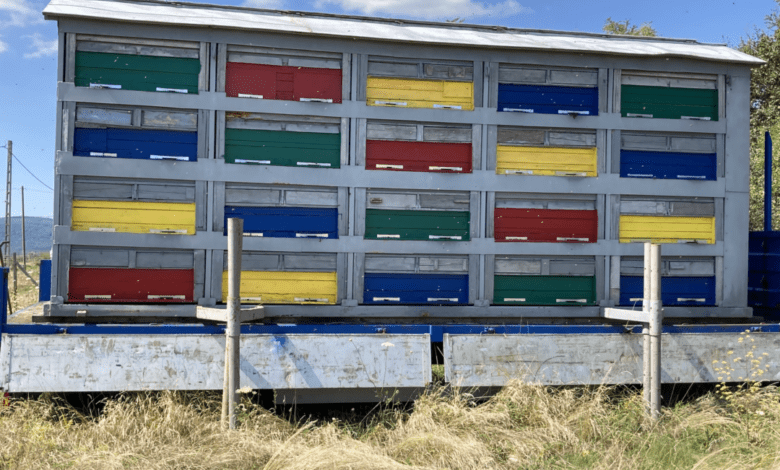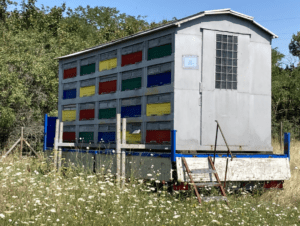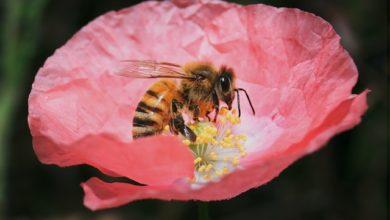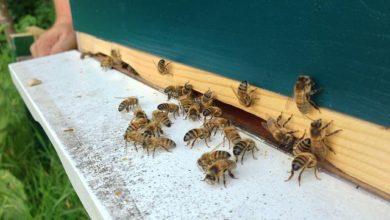Should You Consider a Beekeeping Trailer?

A beekeeping trailer is a mobile unit specifically designed to house and transport beehives, beekeeping equipment, and the necessary tools for beekeepers on the go. This innovative concept offers beekeepers a convenient and efficient way to move their hives between locations, allowing them to take advantage of diverse foraging opportunities and optimize honey production.
Types of Beekeeping Trailers
Beekeeping trailers come in both open and enclosed versions. Open-front beekeeping trailers are usually single-axle trailers, whereas enclosed trailers are commonly two-axle trailers for extra load support.
All beekeeping trailers are also built with specifically sized dimensions to accommodate a beekeeping hive, typically 16 inches in width and 18 inches in height.
Advantages of Using a Beekeeping Trailer
Here are the numerous advantages that come with incorporating a beekeeping trailer into your beekeeping activities. From increased mobility and flexibility to improved bee safety, using a beekeeping trailer offers several benefits that can enhance your overall beekeeping experience.
– Mobility and Flexibility in Beekeeping Operations
One of the primary advantages of using a beekeeping trailer is the increased mobility and flexibility it provides in your beekeeping operations. With a beekeeping trailer, you can easily transport your beehives to different locations, taking advantage of varying flowering cycles or moving your bees to more favorable foraging areas.
This mobility allows beekeepers to optimize honey production and honeybee health by relocating hives to areas with abundant nectar sources or reducing exposure to unfavorable environmental conditions.
Additionally, a beekeeping trailer enables beekeepers to participate in migratory beekeeping, which involves moving beehives to pollinate specific crops or access seasonal nectar flows in different regions. The ability to effortlessly transport and relocate hives provides beekeepers with unparalleled flexibility, making it easier to adapt to changing circumstances and maximize the productivity of their colonies.
– Protection of Bees During Transportation
Another significant advantage of using a beekeeping trailer is the enhanced protection it offers to bees during transportation. Bees are highly sensitive creatures that can be easily stressed or disoriented by movement or loud vibrations.
When transporting beehives on the road, these vibrations could potentially disturb the bees and cause unnecessary harm or agitation. A beekeeping trailer, specifically designed to minimize vibrations and sudden movements, provides a stable and secure environment for the bees during transportation. The trailers are equipped with features such as specialized racks, frames, or containers that hold the hives securely in place, preventing them from shifting or tipping over.
This careful handling allows the bees to remain calm and undisturbed, reducing stress-related issues and ensuring their safety throughout the journey. Additionally, the enclosed design of many beekeeping trailers protects the bees from wind, rain, and excessive exposure to sunlight, further safeguarding their well-being during transportation.
– Efficient Use of Space and Resources
The efficient utilization of space and resources is yet another advantage associated with using a beekeeping trailer. As beekeeping requires ample space for hive placement, a beekeeping trailer provides an organized and compact solution for hive transportation and storage. These trailers come with well-designed compartments or racks that allow beekeepers to stack and secure multiple hives efficiently.
By utilizing vertical space within the trailer, beekeepers can transport a larger number of hives at once, optimizing the use of their vehicles and minimizing the number of trips required.
Additionally, beekeeping trailers often feature integrated storage areas for essential beekeeping equipment, such as protective gear, hive tools, and supplemental feeding supplies. This built-in storage capability ensures that all necessary items are easily accessible and minimizes the need for additional vehicles or trailers to carry these essential resources. By streamlining the transportation and storage process, beekeeping trailers allow beekeepers to maximize their time and resources, ultimately leading to increased efficiency and productivity.
– Enhanced Safety for Beekeepers
Last but not least, using a beekeeping trailer offers enhanced safety for beekeepers. Beekeeping can expose individuals to various hazards, including bee stings, lifting heavy hives, or even accidents while transporting hives on the road.
However, with a purpose-built beekeeping trailer, beekeepers can significantly reduce these risks. The secure and stable design of the trailer ensures that hives remain stationary during transit, minimizing the likelihood of accidental lid openings or hive spills. This stability grants beekeepers peace of mind by eliminating the need to worry about potential damage to the hives or being exposed to aggressive bees due to sudden movements.
Furthermore, beekeeping trailers often come equipped with features like ramps or lifting mechanisms to assist in the safe loading and unloading of hives. These tools help alleviate the physical strain of lifting heavy bee boxes and reduce the risk of back injuries or muscle strains. Ultimately, by prioritizing beekeeper safety, beekeeping trailers provide a secure and controlled environment for both the bees and those tending to them.
Considerations before Investing in a Beekeeping Trailer
Investing in a trailer can greatly facilitate the beekeeping process, making it more convenient and efficient. However, before making this investment, there are several important considerations that beekeepers should take into account.
Budget and Cost Analysis
- Determine your budget: Before investing in a beekeeping trailer, it is crucial to establish a realistic budget that suits your financial situation. Consider both the initial purchase cost and the ongoing expenses associated with owning a trailer, such as maintenance, repairs, and insurance.
- Research trailer options: Conduct thorough research to explore various trailer options available in the market. Compare prices, features, and customer reviews to find a trailer that meets your specific beekeeping needs while staying within your budget.
- Consider used trailers: If you have a limited budget, purchasing a used beekeeping trailer might be a cost-effective option. However, thoroughly inspect the trailer for any damages or defects before making a purchase, ensuring it is still in good working condition.
Local Regulations and Permits Required
- Research local regulations: Different regions have specific regulations and requirements regarding the transportation of beehives. Before investing in a beekeeping trailer, carefully examine the rules and regulations governing beekeeping and trailer transportation in your local area.
- Obtain necessary permits: Some jurisdictions may require beekeepers to obtain permits or licenses for transporting beehives. Make sure to acquire all the necessary permits and comply with local regulations to avoid any legal issues or fines.
- Understand weight restrictions: In some areas, there are weight restrictions for trailers on certain roads or bridges. Ensure that the trailer you intend to purchase complies with these restrictions to prevent potential problems during transportation.
Maintenance and Care Requirements
- Regular inspections: Beekeeping trailers, like any other equipment, require regular inspections to ensure they are in good working condition. Check for any signs of damage, such as rust, wear, or loose fittings, and promptly address any issues to maintain the trailer’s longevity.
- Cleaning practices: Bees can produce wax and propolis, which may accumulate inside the trailer over time. Regularly clean the trailer’s interior to prevent the buildup of these substances, as they can negatively impact hive transportation and compromise bee health.
- Tire and wheel maintenance: The trailer’s tires and wheels should be regularly inspected and properly maintained. Check tire pressure, tread wear, and ensure the wheel bearings are adequately lubricated. This ensures safe and smooth transportation of the beehives.
Choosing the Right Beekeeping Trailer
Here are some of the factors to consider when choosing the right beekeeping trailer, including individual needs, trailer specifications, and customizable options. Whether you are starting a new apiary or expanding your current one, this guide will help you make an informed decision for your beekeeping operation.
Factors to Consider Based on Individual Needs and Preferences:
When selecting a beekeeping trailer, it is crucial to assess your individual needs and preferences. Consider the following factors:
Size and Capacity:
- Determine the number of hives and equipment you need to transport regularly.
- Choose a trailer that provides sufficient space and weight capacity for your needs.
- Consider the possibility of future expansion and accommodate accordingly.
Mobility and Maneuverability:
- Assess the accessibility of your apiary locations. Will the trailer be able to navigate narrow roads, steep terrain, or tight spaces?
- Consider the suspension system, wheel size, and axle configuration to ensure smooth transportation.
Durability and Weather Resistance:
- Beekeeping often involves exposure to various weather conditions. Select a trailer made from durable materials, such as steel or aluminum, to withstand frequent use and harsh elements.
- Look for features like corrosion-resistant coating and sealed compartments to protect your hives and equipment from moisture and pests.
Evaluating the Trailer’s Size, Weight Capacity, and Other Specifications

Understanding the specifications of a beekeeping trailer is vital to ensure suitability for your requirements. Consider the following aspects:
Trailer Size:
- Measure the dimensions of your hives, including height, width, and length, to choose a trailer that accommodates them comfortably.
- Ensure there is enough space for handles, frames, and other beekeeping equipment.
Weight Capacity:
- Calculate the weight of your hives and equipment when fully loaded for transportation.
- Choose a trailer with a weight capacity that exceeds your requirements to ensure safe transportation.
Hitch Type:
- Consider the type of hitch required to attach the trailer to your vehicle (e.g., ball hitch, gooseneck hitch, bumper mount).
- Ensure compatibility between your vehicle’s hitch system and the trailer.
Understanding Additional Features and Customizable Options
Apart from size and specifications, beekeeping trailers may offer additional features and customizable options to enhance functionality and convenience. Consider the following:
Storage Compartments:
- Look for trailers with built-in compartments or storage areas to organize and secure beekeeping tools, protective gear, and other supplies.
- Consider additional features like lockable doors and adjustable shelving for efficient storage.
Ventilation and Insulation:
- Some trailers offer ventilation options, such as vents, windows, or fans, to regulate temperature inside the trailer during transportation.
- Insulated trailers are ideal for protecting bees from extreme heat or cold weather conditions.
Customization:
- Evaluate customizable options, such as adjustable racks, removable partitions, or hydraulic lifts, to tailor the trailer according to your specific needs.
- Customization ensures that the trailer can adapt to different hive configurations and beekeeping methods.
Tips for Utilizing a Beekeeping Trailer Effectively
From ensuring the safety and comfort of bees during transportation to maintaining and regularly inspecting the trailer, attention to detail is key.
Proper Planning and Organization of Beekeeping Operations
- Understand Your Beekeeping Goals: Before you even consider using a beekeeping trailer, it’s essential to have a clear understanding of your goals and objectives. Whether you aim to transport bees for pollination services or relocating colonies, knowing what you wish to achieve will guide your planning process.
- Map Out the Route: Plan the route you intend to take, taking into account the best roads for a smooth and safe journey. Avoid areas with excessive traffic or rough terrain that could potentially disrupt and stress the bees. Remember, a peaceful journey ensures the overall well-being of your colony.
- Weather Check: Keep a close eye on the weather forecast before setting off on your journey. Avoid transporting bees during extremely hot or cold temperatures, as such conditions can be harmful to their health. Opt for milder weather conditions whenever possible.
Ensuring the Safety and Comfort of Bees During Transportation
- Secure the Hive: The hive must be securely fastened to the trailer to prevent any movement during transportation. Use high-quality straps or nets to keep the hive in place effectively. Make sure the hive is level to minimize stress on the bees.
- Ventilation: Bees require proper airflow, even during transportation. Provide adequate ventilation inside the trailer to prevent overheating and excessive humidity. Install vent screens or adjustable vents to ensure a comfortable environment for the bees.
- Adequate Space: Bees need sufficient space to move around and ensure proper ventilation within the hive. Avoid overcrowding the hives during transportation, as it can lead to stress and increased aggression among the bees.
- Block the Entrance: Securely block the entrance of the hive during transportation to prevent bees from escaping or becoming disoriented. Ensure the blocking method provides sufficient airflow while preventing any bees from escaping.
Maintenance and Regular Inspections of the Trailer
- Regular Checkups: Prioritize the regular inspection and maintenance of your beekeeping trailer. Check for any signs of damage or wear and tear, ensuring all parts, such as tires, lights, and brakes, are in proper working condition. Promptly address any issues or repairs necessary.
- Cleaning and Sanitization: Clean the trailer thoroughly after each use to prevent the accumulation of dirt, debris, or potential pests. Sanitize the interior to maintain a hygienic environment for the bees during transportation. Avoid using harsh chemicals that could harm the bees, opting for bee-friendly cleaning solutions instead.
- Storage Considerations: When the beekeeping season comes to an end or during extended periods of inactivity, properly store the trailer in a secure and sheltered location. Protect the trailer from harsh weather conditions and potential damage, extending its lifespan and efficiency.
Overcoming Potential Challenges in Moving Hives
Now, we will explore two common challenges faced by beekeepers – dealing with possible bee infestations or accidents during transportation and navigating logistical issues when moving hives. We will also provide informed strategies and solutions to overcome these challenges effectively.
Dealing with Possible Bee Infestations or Accidents during Transportation:
Understand the risks:
- Beekeeping involves the handling and transportation of live insects, which inherently carries some level of risk.
- Be aware of potential bee infestations, such as Varroa mites or small hive beetles, that can weaken or destroy your colonies, especially during transportation.
- Accidents during transportation, such as hive damage or unintentional release of bees, can lead to disastrous consequences for both the bees and beekeeper.
Ensuring safe transportation:
- Prioritize the well-being of your bees by securing hives properly during transportation.
- Use sturdy and ventilated transport containers, designed specifically for beekeeping, to minimize stress and potential hive damage.
- Regularly inspect hives for signs of insect infestations before transportation, and take necessary measures to mitigate or eradicate pests.
- Secure any openings of the transport containers with fine mesh to prevent bees from escaping while ensuring proper ventilation.
Preparedness for emergencies:
- Accidents can happen, so it is crucial to be prepared for any unforeseen circumstances.
- Keep a beekeeping first aid kit handy, including essential items like a smoker, protective gear, sugar water solution, and a queen cage.
- Familiarize yourself with basic beekeeping emergency protocols, such as how to recapture escaped bees or treat injured colonies.
- Maintain open communication with local beekeeping communities, who can provide valuable advice and support during emergencies.
Navigating Logistical Issues when Moving Hives
Planning and organization:
- Before moving hives, conduct a thorough evaluation of the new location to ensure it meets the necessary requirements for successful beekeeping.
- Plan the logistics well in advance, considering factors such as distance, weather conditions, and accessibility.
- Communicate and coordinate with transportation services or any additional help required to ensure a smooth and timely move.
Minimizing stress for bees:
- Moving hives can be stressful for the bees, potentially affecting their health and productivity.
- Time the move appropriately, preferably during periods with reduced bee activity, such as early morning or evenings, to minimize disruptions.
- Reduce the movement of frames inside the hive as much as possible to maintain brood and comb integrity.
- Offer adequate ventilation during transportation to prevent overheating or suffocation of the bees.
Post-relocation hive management:
- Once the hives have been successfully moved, closely monitor the bees’ adjustment to their new surroundings.
- Provide bees with necessary food sources, such as pollen and nectar, to aid their acclimatization process.
- Regularly inspect the hives after relocation to identify and address any potential issues promptly.
- Be prepared to offer additional support, such as supplemental feeding, if needed, to help the colonies regain their strength.
Conclusion
Beekeeping is an enjoyable and rewarding hobby, and having the means to transport your bees is an important part of it. Beekeeping trailers offer several advantages, from temperature insulation to access to remote locations, making them a great tool to ensure optimal beekeeping conditions.
With a well-insulated and spacious trailer in tow, you’ll have the perfect balance between efficiency and safety as your beekeepers and their sweet passengers hit the road.

FAQ
Why should I consider using a beekeeping trailer?
- Using a beekeeping trailer offers several advantages, including the ability to easily transport your beehives to different locations, optimize hive management, protect bees during transportation, and ensure your equipment is organized and protected.
Is a beekeeping trailer suitable for beginner beekeepers?
- Absolutely! Beekeeping trailers are used by beekeepers of all experience levels. They offer a user-friendly solution for transporting beehives, and the convenience and organization they provide can greatly simplify hive management, making it easier for beginners to transition into beekeeping.
Are there any legal requirements or regulations when using a beekeeping trailer?
- The specific requirements and regulations relating to beekeeping trailers may vary depending on your location. It is crucial to consult your local beekeeping association or agricultural authorities to ensure compliance with any necessary permits, safety standards, or transportation regulations.
Where can I purchase a beekeeping trailer?
- Beekeeping trailers can be purchased from specialized beekeeping equipment suppliers, agricultural equipment dealers, or custom trailer manufacturers. Online platforms and local beekeeping associations may provide you with additional resources to find a suitable beekeeping trailer supplier.




